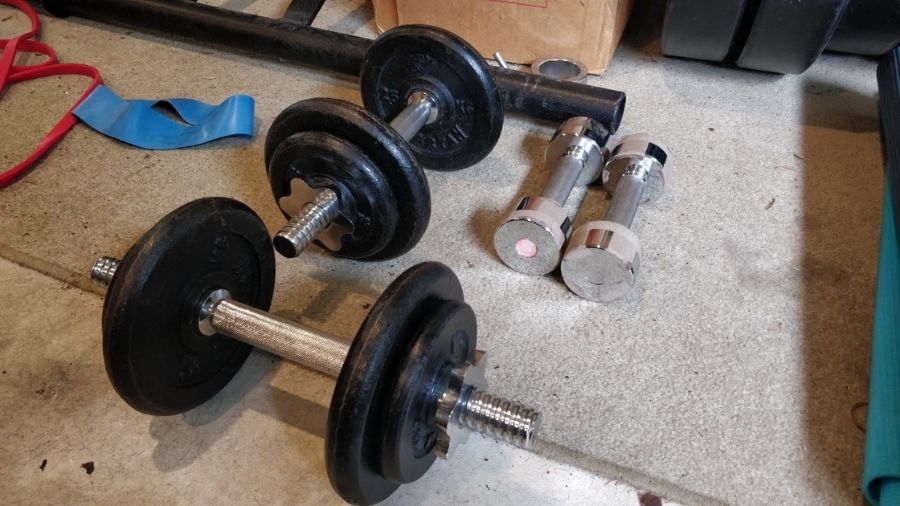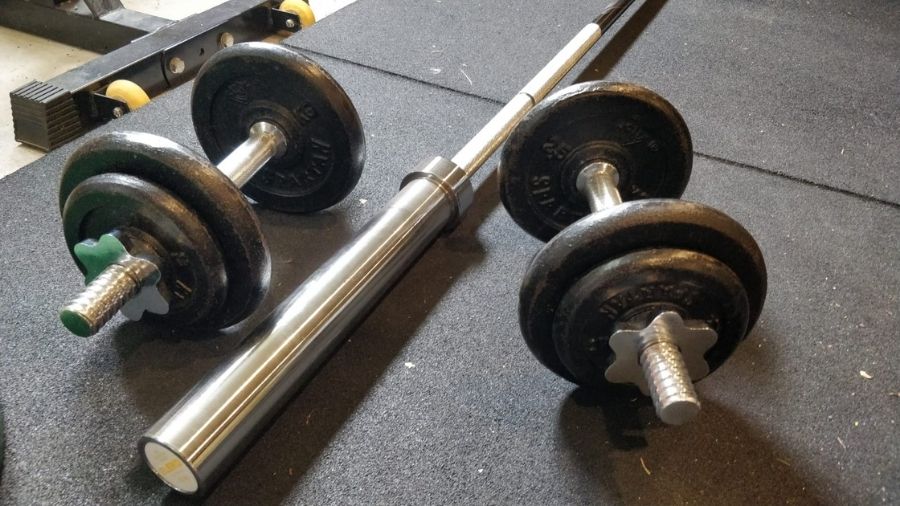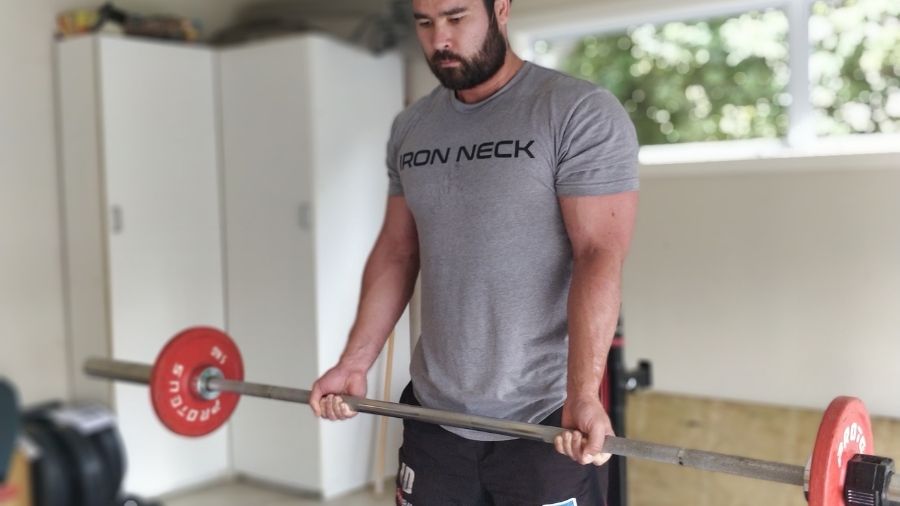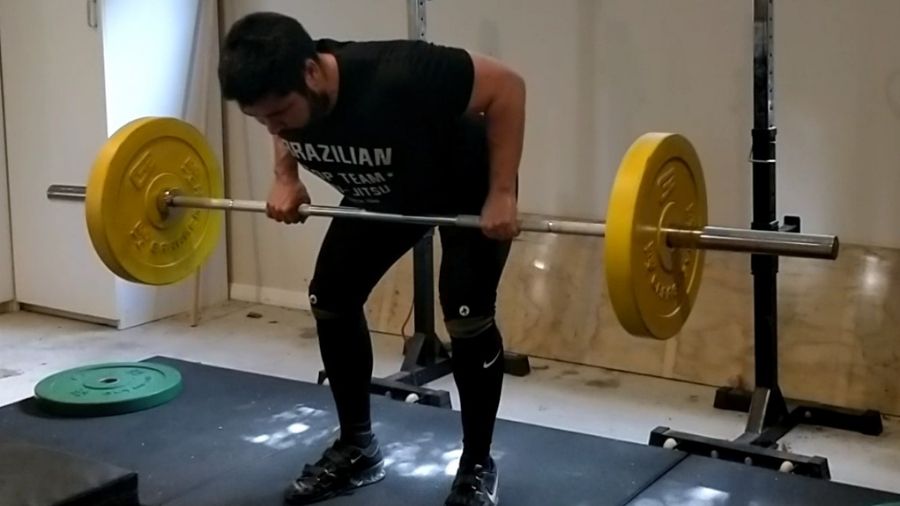You may be wondering if you should use barbells or dumbbells in your training. Or which you should go for in your home gym. The barbell vs. dumbbell debate has been going on for decades with many people solely on either side.
Barbells allow for heavier loads and more reps whereas dumbbells allow for larger ranges of motion in a joint-friendly manner that can reduce muscle imbalances. If you are looking to maximize strength, choose barbells. If muscle growth is your goal, use both barbells and dumbbells.
These aren’t the only differences between dumbbells and barbells. You may be surprised to know that some exercises favor the use of one over the other.
Table of Contents
Benefits Of Using Barbells
Use Heavier Loads
We know that heavier loads through stretch maximize mechanical tension which is a key driver of muscle growth [1]. Barbells allow heavier loads to be used compared to dumbbells for all exercises. For example, the 1RM load for the barbell bench press has been shown to be approximately 17% higher than 1RM dumbbell bench press [2].
Therefore, we could speculate that the use of the barbell leads to greater muscle growth and strength response.
Fewer Exercise Options
Having fewer options sounds like a negative. However, having fewer exercise options means you are forced to use the basic compound movements. These are the cornerstone of your strength and hypertrophy development.
You can make huge strength and size gains with just the basic barbell movements and even if you have other exercise options such as dumbbells and machines, the barbell should make up the bulk of your program.
Increased Stability
The reason you’re able to lift heavier loads with the barbell compared to dumbbells is the increased stability. Being more stable allows you to exert more force. That is why those who are seeking to maximize hypertrophy don't perform exercises on Swiss balls or Bosu balls (not that you should anyway).
Greater Power Output
The increased stability doesn’t just mean more increased force. It means increased peak and average power and velocity compared to dumbbells [3]. So, if strength and performance are your goals, then barbells are far superior to dumbbells.
More Reps At Similar Loads
When using similar loads, for example, a 90 kg bench press vs. a 45 kg dumbbell bench press in each hand, more reps can be performed using the barbell [4]. If you can perform more reps, that means you are performing more volume and creating greater mechanical tension and metabolic stress.
There is a dose-response relationship between volume and muscle growth meaning the more sets and reps performed, the greater the hypertrophy response [5].
Metabolic stress is the other part of the hypertrophy equation where the build-up of waste products from energy production to fuel the muscle contraction each rep is another key mechanism [6].
Benefits Of Using Dumbbells

Greater Range Of Motion
One big advantage of using dumbbells is the increased range of motion. At least with upper body exercises. We know that range of motion plays a critical role in muscle growth where those who lift with partial ranges of motion do not see the same hypertrophic benefits as those who exercise with a full range of motion [7].
A greater range of motion also leads to increased mechanical tension even with lighter loads as the eccentric phase is longer which is vital for hypertrophy [1].
Increased Muscle Activation
You might be surprised to know that dumbbells can elicit greater muscle activation than barbells even at lighter loads. For example, greater pectoralis major activation was seen during the dumbbell bench press compared to the barbell bench press even at a lower absolute load [8].
However, you’re not going to see the same results for the quadriceps for example during the squat as the barbell or dumbbell doesn’t influence the depth.
Reduce Muscle Imbalances
Because dumbbells are two separate implements, you are pushing or pulling equally with both arms. Whereas with the barbell, you can potentially be pushing or pulling more with one arm or the other. Incorporating dumbbell training within your routine can help to reduce these imbalances that can form over time with exclusive barbell training.
More Exercise Variety
While I mentioned that fewer options are a benefit of barbell training, there is also a benefit to having more options. It can keep your training routine fresh increasing your motivation to train. It also reduces the monotony of training which can reduce your risk of injury.
Joint Friendly
Dumbbells can be considered more joint-friendly than barbells as your arms aren't fixed. Your hands can rotate naturally as you press or pull because you're not fixed to a barbell. This is especially important for those that have shoulder problems when bench pressing or overhead pressing.
Barbells vs. Dumbbells For Strength
If strength is your ultimate goal, then barbells are your tool of choice. You’re able to lift heavier loads which is a prerequisite for strength development. Lifting with loads greater than 70% 1RM will get you stronger.
Trying to load 70% 1RM or more with dumbbells for a squat or deadlift is near impossible. Further, to exert the greatest force during the exercise, you need to be stable. Barbells are inherently more stable than two dumbbells.
Barbells vs. Dumbbells For Mass

Barbells are still the king when it comes to building mass as you’re able to lift heavier loads and perform more reps. However, that doesn’t mean dumbbells are useless. Dumbbells allow you to get a larger range of motion for upper body exercises leading to longer eccentric phases and mechanical tension.
Further, they make it easier to load single leg lower body exercises as holding dumbbells at your side lowers your center of mass compared to having a barbell on your back. A lower center of mass equals greater stability.
Barbells vs. Dumbbells For Chest
It is always an area of debate. Should you use barbells or dumbbells to get a big chest. The answer is to use both. The barbell bench press will allow you to use heavier loads maximizing mechanical tension on the pecs. The dumbbells allow you to get a bigger stretch on the pecs.
However, some lifters will find they can’t feel their pecs working with the barbell bench press. Instead, they feel most of the work occurring at the shoulders and triceps. That is when dumbbells may be better for chest development compared to the barbell.
But there is no reason you can’t do both (equipment dependent). Start your workout with the barbell bench press for relatively heavy loads between 5-8 reps. Then move to the dumbbell bench press for slightly higher reps in the range of 8-12 reps.
Barbells vs. Dumbbells For Beginners
There is no reason for a beginner to choose one or the other.
Beginners can use both the barbell and dumbbells and should to expose them to as many different movements as possible.
I understand programs like Starting Strength can be great for beginners as it is a hyper-focused barbell program so a beginner can quickly learn the basic compound movements and make fast progress.
However, it puts the lifter in a movement shoebox where they will struggle with other exercises and implements as they haven't learned how to use them. That is why I believe a beginner should learn to use both barbell and dumbbell exercises so they are exposed to a wide range of movements.
As they advance as lifters, they are not going to fall into the trap of trying to lift unstable loads like dumbbells with weights greater than they can handle as they have trained the ability to stabilize.
When To Switch From Dumbbells To Barbell
Ideally, you haven't pigeonholed yourself into only using dumbbells before using the barbell. Both can be used synergistically. However, if you've only trained with dumbbells, it doesn't matter how long you've used them to start using the barbell.
If you just started using dumbbells, also use barbells. If you’ve been training for a year with only dumbbells, also start using barbells.
Barbell vs. Dumbbell Exercises
When it comes to the barbell vs. dumbbell debate, many will argue one or the other for certain exercises. As the example above illustrated, both barbells and dumbbells are great for chest development even though many will be on the side of dumbbells. So here is my take for each exercise to decide how you should use barbells or dumbbells.
Curls

The barbell curl has been a staple exercise for developing huge biceps for decades. See any old bodybuilding training footage and you’ll see heavy barbell curls. They allow you to use the heaviest load compared to other exercises.
However, it can’t be the only implement you use. Why? Firstly, you only have two hand positions. Supinated and pronated. These target the biceps and brachioradialis but not the brachialis which is preferentially hit with a neutral grip.
Secondly, the barbell places the arms in front of the body at the bottom position. The problem with this is that the biceps cross both the elbow and shoulder joint meaning the barbell doesn’t allow the biceps to fully stretch.
Dumbbells on the other hand allow a larger range of motion as the dumbbells are at your side so you get a bigger stretch. Bonus points for performing the seated incline dumbbell curl as it maximizes the stretch on the biceps.
So, use the barbell for heavier loads of 8-10 reps and dumbbells for the bigger stretch with reps anywhere from 8-20.
Shoulder Press
Interestingly, it seems that dumbbells may be superior to the barbell for the overhead press for developing the shoulders. Research shows activation of all three heads of the shoulder (anterior, medial, and rear) is greater when pressing with dumbbells vs. barbells [9].
However, the barbell overhead press allows for a greater 1RM and far greater triceps activation compared to dumbbells. So, if triceps are your priority or strength is your pursuit, then the barbell is the best option.
If your goal is pure hypertrophy of the shoulders, you could probably skip the barbell and only use dumbbells when it comes to the shoulder press.
Shrugs
Personally, I prefer shrugs using dumbbells. It allows for your arms to hang by your side leaving your shoulders in a neutral position. With the barbell, your shoulders are pulled forward and your junk can often get in the way (ladies don’t need to worry).
You don’t need to shrug heavy either to get big traps. Your various deadlifts and pulls will grow your traps with heavy loads. Shrugs are just the icing on the cake. Perform them with a 2-3 second squeeze at the top and you'll be able to use dumbbells very effectively.
Row

The barbell row is a staple mass builder. It is considered the best back exercise for mass as it activates the muscles of the back to the highest degree [10]. So don’t skip using the barbell.
However, dumbbells have their own advantages for training the back. That is being able to train one side at a time for symmetrical development and being able to row a greater range of motion.
The barbell stops once it touches your stomach. And when the arms are fully extended, the barbell hangs straight down. Using the DB row as an example, you can let the shoulders hang at the bottom for a stretch and row the dumbbell further because your body is not in the way.
Use the barbell for heavy rows with reps ranging from 5-10 and dumbbells for a range of loads in the 8-20+ rep range.
Lunges
Lunges have a balance component that other exercises don’t as you are moving with your legs split in front and behind. That is why I recommend using dumbbells for lunges as it lowers your center of mass improving your balance helping you produce more force and focus on the leg muscles doing the work.
Barbells can help with heavier loading but you're often not performing lunges as a heavy lower body movement. That's what squats and leg presses are for. Lunges are there for more volume without the full-body fatigue to grow big quads and glutes.
Incline Bench Press
The incline bench press follows the same rules as the flat bench press. Use barbells for heavier loads to maximize mechanical tension and dumbbells as an accessory exercise to have greater activation of the pecs and a larger range of motion.
Some lifters may find the barbell incline press is rough on their shoulders. This can be a mobility or structural issue. For these individuals, only using dumbbells is the option.
Deadlift
Now we get to the exercises where barbells reign supreme. Your big lower body compound movements need to use the barbell. It’s as simple as that. You can’t get heavy enough loads with dumbbells and hold dumbbells with heavy loads while deadlifting is much harder than a barbell making your grip strength a limiting factor.
One example where you could use dumbbells instead of a barbell would be the Romanian deadlift if you are using lighter loads. However, the barbell will always be the number one choice when it comes to deadlifting.
If you are doing single-leg Romanian deadlifts, then you will use a dumbbell. The general rule is single-leg exercises use dumbbells; bilateral leg exercises use barbells.
Squat

The squat is no different from the deadlift in that you should use the barbell to maximize your gains. The dumbbell is often used as a teaching tool with the goblet squat. However, you’re never going to build big, strong, and powerful legs only goblet squatting.
At some point, you need to load a barbell on your shoulders or back. Squat with barbells, not dumbbells.
Barbell vs. Dumbbell For Home Gym
When it comes to your home gym, I highly recommend starting with a barbell and only buying dumbbells when you have the basic equipment. The basic equipment being a barbell, plates, a squat stand or power rack, and some kind of platform whether that’s bought or homemade.
Why do I recommend barbells for your home gym instead of dumbbells? A couple of reasons:
Most exercises that you can perform with dumbbells you can perform with a barbell. The same can’t be said for barbell exercises as you can't use dumbbells for heavy squats and deadlifts. Therefore, start with a quality barbell and scour the Facebook marketplace and Craigslist for cheap second-hand dumbbells.
Your other option is to look for loadable Olympic dumbbell handles as then you can just load small plates as you need. These are a good pair of Olympic dumbbell handles.
Summary
There you have it. The barbells vs. dumbbells debate has been settled. Using both barbells and dumbbells is important for maximizing muscle growth. For pure strength and power development, you really only need the barbell. However, periodic dumbbell training can keep you healthy so you can continue hitting the big weights.
References
1. Schoenfeld, B. J. (2010). The mechanisms of muscle hypertrophy and their application to resistance training. The Journal of Strength & Conditioning Research, 24(10), 2857-2872.
2. Saeterbakken, A. H., van den Tillaar, R., & Fimland, M. S. (2011). A comparison of muscle activity and 1-RM strength of three chest-press exercises with different stability requirements. Journal of sports sciences, 29(5), 533-538.
3. Littlefield, J. D., Schramm, K. K., & Mayhew, J. L. (2021). Comparison of lift velocity and power output between barbell and dumbbell bench presses. Journal of Trainology, 10(1), 5-9.
4. Heinecke, M. L., Mauldin, M. L., Hunter, M. L., Mann, J. B., & Mayhew, J. L. (2021). Relationship of Barbell and Dumbbell Repetitions With One Repetition Maximum Bench Press in College Football Players. The Journal of Strength & Conditioning Research, 35, S66-S71.
5. Schoenfeld, B. J., Ogborn, D., & Krieger, J. W. (2017). Dose-response relationship between weekly resistance training volume and increases in muscle mass: A systematic review and meta-analysis. Journal of sports sciences, 35(11), 1073-1082.
6. Schoenfeld, B. J. (2013). Potential mechanisms for a role of metabolic stress in hypertrophic adaptations to resistance training. Sports medicine, 43(3), 179-194.
7. Bloomquist, K., Langberg, H., Karlsen, S., Madsgaard, S., Boesen, M., & Raastad, T. (2013). Effect of range of motion in heavy load squatting on muscle and tendon adaptations. European journal of applied physiology, 113(8), 2133-2142.
8. de Araújo Farias, D., Willardson, J. M., Paz, G. A., Bezerra, E. D. S., & Miranda, H. (2017). Maximal strength performance and muscle activation for the bench press and triceps extension exercises adopting dumbbell, barbell, and machine modalities over multiple sets. The Journal of Strength & Conditioning Research, 31(7), 1879-1887.
9. Saeterbakken, A. H., & Fimland, M. S. (2013). Effects of body position and loading modality on muscle activity and strength in shoulder presses. The Journal of Strength & Conditioning Research, 27(7), 1824-1831.
10. Holly Edelburg, B.S., John P. Porcari, Ph.D., Clayton Camic, Ph.D., Attila Kovacs, Ph.D., and Carl Foster, Ph.D., with Daniel J. Green. ACE-SPONSORED RESEARCH: What Is the Best Back Exercise?
